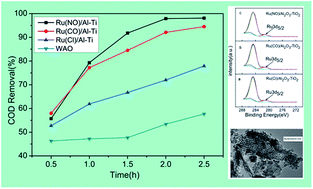Abstract:RuCl3, Ru-3(CO)12 and Ru(NO)(NO3)3 were used as Ru precursors to prepare supported Ru catalysts by an impregnation method. The effect of the precursors on the catalysts was investigated in the catalytic wet air oxidation (CWAO) of high concentration organic compounds. The surface properties of the catalysts were characterized by BET, XRD, XPS, TEM and H-2-TPR. The different Ru precursors led to different particle sizes and distributions, reducibilities, and content of chemisorbed as-synthesized catalysts, which resulted in discrepancies in their catalytic performances. The order of the catalyst activity was as follows: Ru(NO)/Al2O3-TiO2 > Ru(CO)/Al2O3-TiO2 > Ru(Cl)/Al2O3-TiO2. The surface structure and the concentration of chemisorbed oxygen on the surface of the catalysts played important roles in the activity of the Ru catalysts in the CWAO of organic compounds.

KeyWords Plus:SUPPORTED RUTHENIUM CATALYSTS; WASTE-WATER; ACETIC-ACID; PHENOL; CARBON; STABILITY; TIO2; 2-CHLOROPHENOL; PARTICLES; RU/ZRO2
Published in RSC ADVANCES, 6 (77):73810-73816; 10.1039/c6ra13235a 2016


